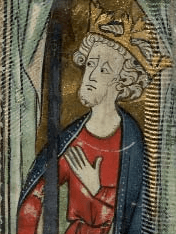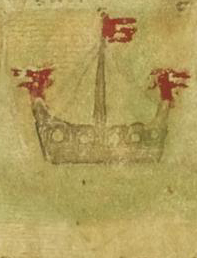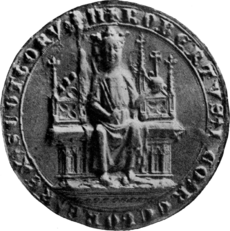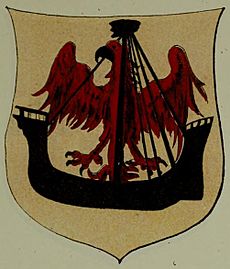Aonghus Óg of Islay facts for kids
Quick facts for kids
Aonghus Óg Mac Domhnaill
|
|
|---|---|
| Lord of Islay | |

Aonghus Óg's name as it appears in a facsimile of correspondence between him and his feudal overlord, Edward I, King of England: "Engus de Yle".
|
|
| Predecessor | Alasdair Óg Mac Domhnaill? |
| Died | 1314 × 1318/c. 1330 |
| Buried | Iona |
| Noble family | Clann Domhnaill |
| Spouse(s) | Áine Ní Chatháin |
| Issue | Eóin (John of Islay) Máire Áine? Eóin (illegitimate) |
| Father | Aonghus Mór mac Domhnaill |
Aonghus Óg Mac Domhnaill (died between 1314 and 1330), also known as Angus Og MacDonald, was an important Scottish leader in the 1300s. He was a chief of Clann Domhnaill, a powerful family group. Aonghus Óg was the younger son of Aonghus Mór mac Domhnaill, Lord of Islay. After his father's death, his older brother, Alasdair Óg Mac Domhnaill, became the chief.
Aonghus Óg is best known for supporting Robert the Bruce, who became King of Scotland. This was during a time when Scotland was fighting for its independence from England. Aonghus Óg's family, Clann Domhnaill, were rivals with another powerful family, Clann Dubhghaill. This rivalry often shaped who Aonghus Óg supported in the bigger wars.
Contents
Aonghus Óg: A Scottish Leader
Aonghus Óg's story is mostly about his role in the Wars of Scottish Independence. These were long and important fights for Scotland's freedom. He played a key part in helping Robert the Bruce become king. His actions helped shape the future of Scotland and his own family.
Early Life and Family Connections
Aonghus Óg was a younger son of Aonghus Mór mac Domhnaill, Lord of Islay. His father was the chief of Clann Domhnaill. This family controlled lands like Kintyre, Islay, and parts of Jura. Clann Domhnaill was a branch of a larger family group called Clann Somhairle. Other branches included their rivals, Clann Dubhghaill, and Clann Ruaidhrí.
Aonghus Óg's mother was from the Caimbéalaigh family, also known as the Campbells. He had several siblings. His older brother, Alasdair Óg, became chief after their father. Aonghus Óg also had a brother named Eóin Sprangach.
Scotland's Fight for a King
After Alexander III, King of Scotland died in 1286, Scotland faced a big problem. There was no clear heir to the throne. Many people, called "competitors," wanted to be king. Edward I, King of England, was asked to help decide. In 1292, John Balliol, Lord of Galloway, became King of Scotland.
However, King Edward I of England wanted to control Scotland. John Balliol's rule lasted only about four years. In 1296, England invaded Scotland and won a big battle at Dunbar. Scotland then came under English control.
Rivalries and Changing Sides
During this time, the chief of Clann Dubhghaill was Alasdair Mac Dubhghaill, Lord of Argyll. He was closely connected to the Balliol family. Alasdair Mac Dubhghaill was made the King of Scotland's representative in many western areas. This included the lands of Clann Domhnaill.
The Clann Domhnaill and Clann Dubhghaill families often fought. This was about land and power. Aonghus Óg's older brother, Alasdair Óg, was involved in these conflicts. At one point, Alasdair Óg worked with the English king. This was likely to gain an advantage over Clann Dubhghaill.
It seems Alasdair Óg died fighting Clann Dubhghaill around 1299. After this, Aonghus Óg likely became the chief of Clann Domhnaill. He continued to support the English king for a while. This was still part of his family's fight against Clann Dubhghaill.
Supporting Robert the Bruce

In 1306, Robert the Bruce killed his main rival for the Scottish throne. He was crowned King of Scots soon after. But the English king fought back, and Robert the Bruce became a fugitive. He had to hide and escape.
Stories say that Aonghus Óg played a very important part in helping Robert the Bruce survive. It is believed that Aonghus Óg protected the king. This was at Dunaverty Castle in Kintyre. Some historians think the king might have gone to Dunyvaig Castle on Islay instead.

Clann Domhnaill's decision to support Robert the Bruce was very important. It helped them gain power against their rivals, Clann Dubhghaill. While the English king ordered a search for Robert the Bruce, he remained hidden. This was likely with the help of Clann Domhnaill and other friendly families.
Rewards and Leadership Changes
Robert the Bruce made a strong comeback in 1307. By 1309, he was firmly in control as king. Clann Domhnaill greatly benefited from supporting him. Aonghus Óg was given large areas of land. These lands had belonged to families who had opposed Robert the Bruce.
For example, Aonghus Óg received the lands of Lochaber, Ardnamurchan, and Glencoe. Another leader, Alasdair of the Isles, received Mull and Tiree. These gifts showed how grateful Robert the Bruce was for their help.

There might have been some disagreements about who was the true chief of Clann Domhnaill during this time. Different leaders might have claimed the title. However, Aonghus Óg was clearly a very important figure. He even wrote to the English king in 1310. In his letter, he called himself "of Islay." This suggests he was acting as the chief.
Battle of Bannockburn Victory

In 1314, a huge battle took place near Stirling. This was the Battle of Bannockburn. It was a major fight between the Scottish and English armies. Robert the Bruce's army was smaller than the English force.
According to old stories, Aonghus Óg was there. He led the men from the Scottish islands and Argyll. His group played a very important part in the battle. They joined the fight at a crucial moment. The battle was a huge victory for Scotland. It was one of the worst defeats for the English. Aonghus Óg's support was very valuable to King Robert.
Supporting the Bruce in Ireland

Aonghus Óg, or a close family member, might have helped in Scotland's campaigns in Ireland. In 1315, Robert the Bruce's brother, Edward Bruce, Earl of Carrick, invaded Ireland. He wanted to become the High King of Ireland.
The Scots and their Irish allies fought against the English and their allies for three years. In 1318, there was a big battle called the Battle of Faughart. Edward Bruce was killed, and the Scottish campaign in Ireland ended. Some old records say that a "Mac Domhnaill, King of Argyll" was killed in this battle. This person might have been Aonghus Óg or one of his sons.
The support of Clann Domhnaill helped destroy their rivals, Clann Dubhghaill. By the middle of the 1300s, Clann Domhnaill was the most powerful family group in the region. This was under the leadership of Aonghus Óg's son.
Death and Legacy
Aonghus Óg died sometime after the Battle of Bannockburn. Some records suggest he died between 1314 and 1318. Others say he died around 1330. He was likely buried on Iona.
After Aonghus Óg, his son, Eóin Mac Domhnaill, became the chief. Eóin was the first person from Clann Domhnaill to be called "Lord of the Isles." This was a very important title. It showed the great power and influence of his family.
Aonghus Óg married an Irish woman named Áine Ní Chatháin. She came from a powerful family in Ulster, Ireland. Their marriage brought many followers and strong connections. Aonghus Óg and Áine Ní Chatháin had a son, Eóin Mac Domhnaill. They also had a daughter named Máire, who married William III, Earl of Ross. Aonghus Óg also had another son named Eóin, who started the Glencoe branch of Clann Domhnaill.
Aonghus Óg's time as chief was marked by his strong support for Robert the Bruce. His son, Eóin, later became even more powerful. He helped establish the title of "Lord of the Isles." This made Clann Domhnaill a dominant force in the Scottish islands.
See Also
Images for kids









